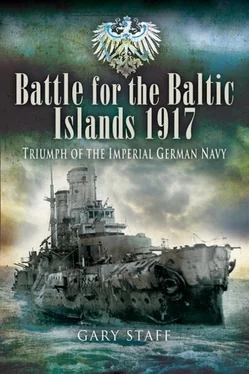In writing this book I did not seek to make any great analysis of the fighting, but rather wanted to present a balanced and accurate narrative that gives the reader a genuine feel for the time, experienced in part through the eyes of those who participated. I wanted to present the story from both sides in a fair and unbiased way. I hope I have achieved this.
Gary Staff, January 2008.
Russian, German and Equivalent Naval Ranks in the First World War
| Russia |
Germany |
Royal Navy |
| —— |
Grosseadmiral |
Admiral of the Fleet |
| Admiral |
Admiral |
Admiral |
| Vice Admiral |
Vizeadmiral |
Vice Admiral |
| Kontre Admiral |
Kontreadmiral |
Rear Admiral |
| —— |
Kommodore |
Commodore |
| Capitan 1st Rank |
Kapitän zur See |
Captain |
| Capitan 2nd Rank |
Fregattenkapitän |
Commander |
| Starchi Leitenant |
Korvettenkapitän |
Lieutenant Commander |
| Leitenant |
Kapitänleutnant |
Lieutenant |
| Oberleutnant zur See |
| Michman |
Leutnant zur See |
Sublieutenant |
| Fähnrich zur See |
Midshipman |
| Praporshchik |
—— |
Ensign |
The campaign and battles on and around the Baltic Islands in October 1917 constituted the largest naval operation to take place in the Baltic during the course of the First World War. The Baltic Islands formed the central axis and pivotal point of naval warfare in the Baltic theatre. The German Commander-in-Chief of the Baltic Theatre (Oberost or ObHdO), Grossadmiral Prinz Heinrich, had long stated the importance and significance of the Baltic Islands, which dominated the entrance to the Riga Gulf and the Finnish Gulf. Ever since the abortive break-in to the Riga Gulf in August 1915, the Baltic Command had consistently restated the importance of capturing these islands as a prerequisite to any further operations into the Riga Gulf. When it became apparent that there were insufficient German forces available for this task, Grossadmiral Prinz Heinrich had reluctantly agreed to the massive and widespread minelaying campaigns of 1916 and 1917.
In the meantime the revolution had occurred in Russia. There was much turmoil in the Imperial Russian Navy and many officers had been murdered and others had been replaced, in a Navy which was already short of trained and experienced officers. Nevertheless, after the chaos of the revolution there was no weakening of resolve on the Russian side, even after the halting of the Kerensky (or so-called 2nd Brusilov) Offensive, and then the German capture of the city of Riga. The Russians were as determined as ever to continue the struggle.
The Moon Sound Archipelago received its name from the passage which in turn took its name from Moon Island. The Moon Sound separates the archipelago from the coast of Estonia. On the continental side is the island of Worms and other low-lying islands. The length of the sound is 35 miles, from Worms in the north, to Moon Island in the south. Moon Sound varies in width from 6 miles in the north to 3.5 miles in the south, and varies in depth from around 105 metres in the north, to about 5 metres near Moon. Between the islands of Dagö and Ösel lies the Kassar Wiek, a shallow stretch of water separated from Moon Sound by the Kumora reef. Along the coast of Moon runs a narrow, natural channel known as the Strumpf , or ‘stocking’, which allows shallow-draught vessels to pass into the Kassar Wiek. The Strumpf was first charted by Colonel MacDonald in 1888, but it was not until twenty-seven years later, in 1915, that the first dredging work was undertaken to increase the depth of Moon Sound. A group of up to seventy dredgers began work to increase the depth to 8.5 metres and then 9 metres, to allow battleships and cruisers to transfer from the Gulf of Finland to the Riga Gulf.
The largest islands of the archipelago are Ösel and Dagö. The Soelo Sound runs between them with a width of about 3 miles, but there are many shoals and small islets, and the water depth seldom exceeds 2 to 3 metres. The island of Ösel is relatively flat, rising to 59 metres elevation in the north and falling away steeply at the coast. It is covered with scattered woods, pastures, marshes, small villages and farms. Many fields are delineated by juniper hedges. There are seven large depressions on Ösel, the largest of which is Lake Kaami. These were formed by meteorites. The south part of Ösel is formed by the Sworbe Peninsula, which has Cape Zerel as its southernmost tip. From Zerel to the Kurland coast is a distance of 16 miles and the Zerel Reef extends out from the cape. There was a large lighthouse at Cape Zerel, which provided an excellent lookout station and was strategically and morally very important. A fresh water spring lay next to the lighthouse.
There were several channels through the passage between the Sworbe Peninsular and Cape Domesnas on the Kurland coast, known as the Irben Straits. The water channels were to the south, but there was also a passage over the Zerel Reef that was known only to the Russians. The deep water passage led directly to Arensburg Bay and Arensburg, the capital city of Ösel.
Arensburg was once a powerful fortress, where the German Bishop Osnabriuksky was based in 1341. For centuries the inhabitants of Ösel Island were known as pirates, but during the Northern War of 1708–1711, and after a plague and famine, the fortress of Arensburg fell to the Russians on 26 September 1710. Emperor Peter I made Arensburg an advanced position in the Baltic, but he was not the only one to appreciate the importance of Moon Sound. During the Swedish-Russian War in 1809 the English supporting Sweden used the northern part of Moon Sound as an anchorage. During the two campaigns of the Crimean War in 1854–55 the English fleet used the Moon Sound archipelago as an anchorage, where they were poised as a threat to St Petersburg. Throughout the First World War the islands of Dagö and Ösel held great significance. With the islands remaining as Russian possessions, the Russian Imperial Navy could still outflank the Germans in the Riga Gulf and had the option of staging a landing on the Kurland coast behind the German lines, or of bombarding the German shore positions more or less at will, which they had done since 1915. From their support bases in the Riga Gulf and Moon Sound the Russian destroyers and Russian and English submarines could penetrate into the middle and western Baltic, striking at German trade routes with Sweden. The Baltic Islands and the Riga Gulf were again pivotal for naval warfare in the Baltic. With the islands in German hands the Riga Gulf, and therefore the German Army rear, would be secure, and the facilities at Riga could be utilized as a supply base to further the German offensive. The Russian ‘Forward Position’, the outer defences of the Finnish Gulf, would be under threat. The continued German offensive and the perceived threat to St Petersburg would increase pressure on the Russian government to conclude peace, and with the conclusion of a negotiated peace vast resources of German men and equipment would be freed to join the battle in the west against America, France and the British Empire.
With all due consideration, orders for the attack on the Baltic Islands were issued on 18 September 1917, and read:
For the domination of the Riga Gulf and the security of the flank of the East Army, a combined attack by the land and sea forces is to take the Islands of Ösel and Moon, and the use of the Greater Moon Sound is to be denied to the enemy sea forces.
Читать дальше












